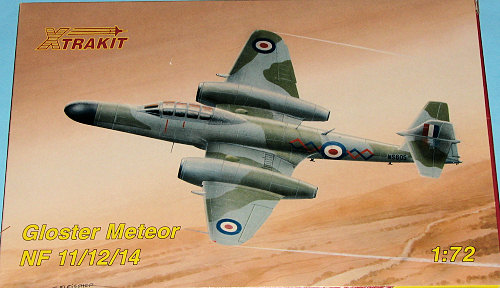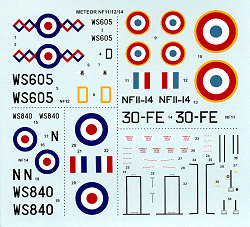
Xtrakit 1/72 Meteor NF 11/12/14
| KIT: | Xtrakit 1/72 Meteor NF 11/12/14 |
| KIT #: | XK72002 |
| PRICE: | $13.45 from GreatModels |
| DECALS: | Three options |
| REVIEWER: | Scott Van Aken |
| NOTES: | Matchbox mold |

| HISTORY |
The Gloster Meteor was the first British jet fighter and the Allies' first operational jet. Designed by George Carter, it first flew in 1943 and commenced operations on 27 July 1944 with 616 Squadron of the Royal Air Force (RAF). The Gloster Meteor was not an aerodynamically advanced aircraft, nor even the world's fastest aircraft on introduction, but the Gloster design team succeeded in producing an effective jet fighter that served the RAF and other air forces for decades. Meteors saw action with the Royal Australian Air Force (RAAF) in the Korean War and remained in service with numerous air forces until the 1970s.
As a night-fighter, the Meteor again replaced the Mosquito, however, it was never more than an interim measure as development of specialised aircraft lagged. Gloster used the T 7 as the base for the NF 11 with the first prototype flying on 31 May 1950. The production models were built by Armstrong Whitworth and had a real mix of parts - the fuselage and tail of the F 8, the longer wings of the F 3, the double canopy of the T 7 and a new extended nose to contain the air intercept radar. The 20 mm cannons were moved into the wings, outboard of the engines. Nos. 29, 141 and 85 Squadrons were given the NF 11 in 1951 and the aircraft was rolled out across the RAF until the final deliveries in 1955. A "tropicalized" version of the NF 11 for Middle East service was developed; first flying on 23 December 1952 as the NF 13. The aircraft equipped No. 219 Squadron RAF at Kabrit and No. 39 Squadron at Fayid, both in Egypt. The aircraft served during the Suez crisis and remained with No. 39 Squadron when they were withdrawn to Malta until 1958. The aircraft had a number of problems, notably the limited visibility through the T 7 canopy made landings tricky and the external fuel tanks under the wings tended to break-up when the wing cannon were fired. Belgium (24), Denmark (20), Australia (one) and France (41) were the foreign customers for the NF 11. Ex-RAF NF 13s were sold to Syria (six), Egypt (six) and Israel (six). Some of the French aircraft remained in operation as test beds into the 1980s.
As radar technology developed, a new Meteor night-fighter was developed to use the APS-21 system. The NF 12 first flew on 21 April 1953. It was similar to the NF 11 but had a nose section 43.2 cm longer; this altered the centre of gravity and the tailplane was enlarged to compensate. The NF 12 also had the new Rolls-Royce Derwent 9 engines and the wings were reinforced to handle the new engine. The RAF operated the NF 12 from August 1953 with seven squadrons equipped up to 1956 (No.s 85, 25, 152, 46, 72, 153 and 65); the aircraft was replaced over 1958-59. Because of the "sensitive" nature of the radar system, no NF 12s were offered for export.
The final Meteor night-fighter was the NF 14. First flown on 23 October 1953, the NF 14 was based on the NF 12 but had an even longer nose to accommodate new equipment pushing total length to 15.5 metres and a larger bubble canopy to replace the framed T 7 version. Just 100 NF 14s were built; they first entered service in February 1954 beginning with No. 25 Squadron and were being replaced as early as 1956 with the Gloster Javelin. Overseas, they remained in service a little longer, serving with No. 60 Squadron at Tengah, Singapore until 1961. As the NF 14 was replaced, some 14 were converted to training aircraft as the NF(T) 14 and given to No. 2 Air Navigation School on Thorney Island where they served until 1965.
| THE KIT |
 This second full kit from Xtrakit is the venerable Matchbox Meteor kit (now owned by Revell), repopped with new decals. The Matchbox Meteor was one of Matchbox's later kits so it does not suffer from the 'mad trencher' as is the case with its earlier kits. In fact, this one has basically raised panel lines for all except flight control surfaces. Unlike the initial releases, it is also molded in one color; a nice light grey. Also unlike the earlier releases, this one is not festooned with sink marks, one of my biggest complaints with the Matchbox releases. In fact, this is a huge improvement as those sink marks were seemingly everywhere, including the wheel hubs. As the wheels on this kit are integrated with the landing gear, it made repair nearly impossible.
This second full kit from Xtrakit is the venerable Matchbox Meteor kit (now owned by Revell), repopped with new decals. The Matchbox Meteor was one of Matchbox's later kits so it does not suffer from the 'mad trencher' as is the case with its earlier kits. In fact, this one has basically raised panel lines for all except flight control surfaces. Unlike the initial releases, it is also molded in one color; a nice light grey. Also unlike the earlier releases, this one is not festooned with sink marks, one of my biggest complaints with the Matchbox releases. In fact, this is a huge improvement as those sink marks were seemingly everywhere, including the wheel hubs. As the wheels on this kit are integrated with the landing gear, it made repair nearly impossible.
The sprues shown are from the Matchbox boxing, but are identical to the Xtrakit's offerings.
The kit is remarkably crisp and clean with only a teeny bit of flash on a few bits. There are, as you might expect, several options. One of which is to be able to make any one of three different variants. This ability is because the kit has separate fins, separate cockpit areas and separate noses. You also have the ability to use large or small intakes, with the later variants more likely to have these than the earlier.
Though this kit isn't quite as basic as earlier models, it still isn't super detailed and will benefit from aftermarket, especially in the cockpit, which is pretty generic with seats, floor, instrument panels and control stick for the pilot.  The kit caters to the different variants with different canopy sections and windscreens. The clear bits are thick but relatively clear. You also have wing and fuselage fuel tanks to round things out. Thanks to the hollow noses, there is plenty of room for nose weight, which you will need.
The kit caters to the different variants with different canopy sections and windscreens. The clear bits are thick but relatively clear. You also have wing and fuselage fuel tanks to round things out. Thanks to the hollow noses, there is plenty of room for nose weight, which you will need.
Instructions seem very much like what was provided by Matchbox and while a bit small for old eyes, should work well. Color information is provided for Xtracolor paints and a generic name is also given for those without access to these fine colors. With three variants it is only logical that three markings options are provided. The NF.11 is a French aircraft with ECN 1/30 in the late 1950s. For the NF.12 we have a nice 64 Squadron plane circa 1957. Finally the NF.14 is also 64 Sq (so that the same fuselage marking can be used, I guess) from 1958. All are in Dark Green uppers, with Medium Sea Grey undersides that carry to the top colors in all but the NF.14 which has Dark Sea Grey along with the Green. Decals are very nicely done and include stencils.
Additional note. I've had a few e-mails that tell me the NF.14 had the same nose extension (17 inches) over the NF.11 as did the NF.12. That being the case, modelers are cautioned to not use the longer nose when doing their NF.14. Use the NF.12 one instead.
| CONCLUSIONS |
Those who have been looking for the Matchbox kit can now find it with Xtrakit. Despite its age, it does make into a very nice model and leaves room for those who want to enhance it even a bit more. I've built several of these and enjoyed every one. I'm sure you will as well.
| REFERENCES |
January 2008
You can find this kit and many others atGreatModels
If you would like your product reviewed fairly and fairly quickly, please contact the editor or see other details in the Note to Contributors.